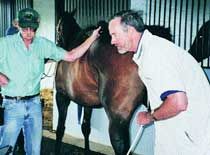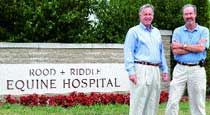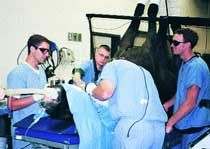Rood & Riddle earns reputation as 'Mayo Clinic for horses'
The notepad on Dr. Bill Rood's desk sums up the work ethic of a hospital whose clientele ranges from the Queen of England to Arab sheikhs. It reads, "Teamwork is the fuel that allows common people to produce uncommon results."
The notepad on Dr. Bill Rood's desk sums up the work ethic of a hospital whose clientele ranges from the Queen of England to Arab sheikhs.

Dr. Tom Riddle, an ambulatory clinican and partner at Rood & Riddle, performs a rectal palpation on a mare at a Lexington horse farm, while a farm assistant looks on.
It reads, "Teamwork is the fuel that allows common people to produce uncommon results."
Such a motto is more than a trendy inspiration to Rood, hospital director of the 175-staff Rood & Riddle Equine Hospital. During a tour of the facility, he unintentionally exhibits his name-recalling ability by correctly greeting everyone from veterinarians to stall assistants.
Rood believes without his staff, Rood & Riddle, one of the leading full-service equine referral centers in the country, wouldn't have the reputation as the "Mayo Clinic for Horses" in Lexington, the proclaimed Horse Capital of the World.
"We hire very skilled professionals, (because) we are the final authority," says Rood, who practiced for 22 years. Most people who work in the hospital also participate in speaking engagements and publish their research.
Breakdown
The staff comprises 36 veterinarians (14 ambulatory), including 13 interns and 135 support staff. The hospital has four surgeons, three internal medicine clinicians, one reproduction specialist, one podiatry clinician and 10 interns.
Such a staff is necessary to maintain the caseload, says Rood, who practiced until five years ago. He says the hospital treats about 10,000 cases annually, including 4,600 surgeries and 1,293 arthroscopies. The most common cases are colic and pneumonia.

Dr. Bill Rood and Dr. Thomas Riddle, partners in practice since 1981, stand in front of Rood & Riddle Equine Hospital, a full-service equine referral center.
The incredible caseload, which peaks in spring due to reproduction, accounts for the multi-million dollar gross revenues, a 17 percent growth over the last decade. That caseload has also dramatically shifted from 80 percent ambulatory cases to 80 percent referred cases to the hospital.
For a hospital that Rood started in 1986 as a solo practitioner with little equipment to his name, progress can't be disregarded. Today, the hospital houses two radiography suites, a nuclear scintigraphy area, an ICU unit and pharmacy.
Staying ahead is crucial, says Rood.
"We'll keep buying, (because) we want to be the leader."
The latest hospital addition is the reproduction and podiatry center, housed under one roof, but operating as two separate entities. Dr. Scott Morrison, a blacksmith and integral part of the new center, is responsible for reversing severe laminitis cases.
Unplanned adversity
Coupled with promising times are troubling times, which thrust Rood & Riddle -and the entire equine community - into the spotlight in 2001.
Dr. Tom Riddle, an ambulatory clinician specializing in reproduction, was the first to report the unusual mare reproductive loss syndrome (MRLS) cases in 2001.

Dr. Rolf Embertson (center) performs a myotomy and palate laser procedure on a sedated horse. Assisting him are (from left) Dr. Kristian Rhein, intern; Ben Rumer, surgery technician; and Doug Cramer, surgery technician.
While performing rectal palpations during fetal sexing procedures, Riddle discovered mares had lost their pregnancies. The ultrasound indicated fetuses were dead.
The first couple of cases were written off as "bad luck". As cases mounted, so did concern from the veterinary community, says Riddle, the first veterinarian to join Rood's practice in 1981 who became partner in 1984.
"Many felt paranoid. It was a very difficult time for the industry," says Riddle who estimates losses of at least $100 million.
The bright side is that in 2002, Riddle estimates he saw only 30 percent of the volume of MRLS cases he evaluated last year.
As if the stress of MRLS case overload wasn't enough, the media also doggedly pursued Riddle. "Because I was the first to report, I talked with everyone from U.S. News to NPR. That was stressful and I can't say I enjoyed it.
"The positive (aspect) about MRLS is that it brought together vets from different practices over a common enemy. We developed a camaraderie and continue to collaborate," he says.
Collaborations on MRLS resulted in several studies involving Rood & Riddle. One study detected effects of frass and caterpillars on pregnant mares, with researchers concluding a direct association between caterpillars and early fetal loss. The hospital is now mulling a study to determine whether a hormone found in caterpillars may cause abortion. Riddle would not discuss specifics.
Global business
On this particular day, Riddle's rounds took him to a multimillion dollar farm owned by an Arab sheikh from the United Arab Emirates.
"Thoroughbred business is very international," says Riddle. "Veterinarians and visitors around the world come to Lexington because of its reputation.
"The big draw is the value of each horse," he continues. "We're rarely limited on veterinary care. It's a pleasure to practice veterinary medicine as you've been taught. The caliber of the management and horsemen is also a big draw. We're working with educated clientele and with assistants (at farms) who know how to handle horses," says Riddle.
Although the hours can be brutal - during the busy season, many clinicians, including ambulatory and hospital, are expected to put in up to 12 hour days, seven days a week - the benefits pay off. Riddle concedes, "We work hard, but we are compensated well."
More importantly, Riddle adds, reflecting the sentiment of his colleagues, "I love my job."
Industry-altering advances
Dr. Larry Bramlage, recognized internationally as a premier equine orthopedic surgeon, has spent 13 years at Rood & Riddle and is one of eight partners. In his tenure, he says certain equipment and procedures have propelled the hospital and the industry to new heights.
Revolutionary technology includes the ultrasound machine, arthroscopic surgery and routine use of bone plates and screws to bring horses back from what used to be career-ending injuries, according to Bramlage.
"To summarize, for many orthopedic injuries, when I first started doing surgery, it was somewhat of a last-ditch effort," he says. "Now orthopedic surgery has changed to where surgery is the first line of defense. Previously, the concern about doing surgery was that the surgery would do as much harm as the injury did."
Beyond duty
Rood is a founding member of Veterinary Management Group III (VMG III), comprised of veterinarians who focus strictly on equine issues. VMG III meets yearly to discuss hot topics, such as fees, and is sponsored by an American Association of Equine Practitioners endowment fund.
Another leader in the horse community, Bramlage, participates in an AAEP On-Call veterinarian program, in which he appears on televised Triple Crown races and other high-profile events. He fields questions from the media pertaining to horse injuries or health in general.
Additionally, the hospital recently sponsored a show jumping event at the Kentucky Horse Park (KHP). It is a fundraiser for a local shelter and KHP Foundation. The hospital also helps serve meals at a homeless center, supports blood center drives, and sends individuals to speak at schools about veterinary careers.